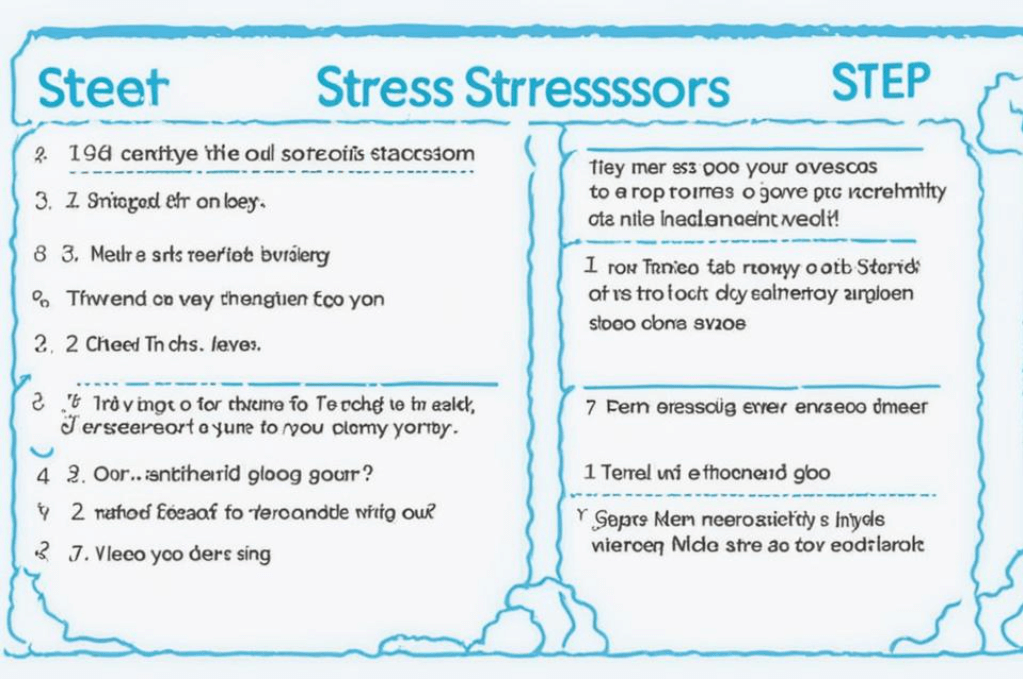In our daily lives, we often experience stress, which can have a negative impact on our well-being. Setting smart goals for stress management can help us effectively reduce and cope with stress. This article will explain the concept of SMART goals and how they can be applied to stress management. We will explore the importance of identifying specific stressors, setting measurable and achievable goals, ensuring relevance, and establishing time-bound goals. Additionally, we will provide strategies and techniques to help achieve these SMART goals for a stress-free life.
Contents
I. Understanding SMART Goals
II. Step 1: Identify Specific Stressors
III. Step 2: Set Measurable Goals
IV. Step 3: Set Goals You Can Actually Achieve
V. Step 4: Make Sure Your Goals Matter to You
VI. Step 5: Set Time-Bound Goals
II. Strategies to Achieve SMART Goals for a Stress-Free Life
VIII. Conclusion
I. Understanding SMART Goals

Setting SMART goals is an effective way to manage stress and achieve a stress-free life. SMART stands for Specific, Measurable, Achievable, Relevant, and Time-bound. Let’s break down what each of these means:
1. Specific: When setting goals, it’s important to be clear and specific about what you want to achieve. Instead of saying, “I want to reduce stress,” you can say, “I want to reduce stress by practicing mindfulness meditation for 10 minutes every day.”
2. Measurable: It’s important to have a way to measure your progress towards your goals. This helps you stay motivated and see how far you’ve come. For example, you can track the number of days you’ve practiced mindfulness meditation or the decrease in your stress levels.
3. Achievable: Setting achievable goals means setting ones that are within your reach. It’s important to be realistic and consider your resources, time, and abilities. For example, if you’re new to meditation, starting with 10 minutes a day might be more achievable than starting with an hour.
4. Relevant: Your goals should be relevant to your specific situation and needs. Consider what is most important to you and what will have the biggest impact on reducing your stress. For example, if work stress is your main concern, setting a goal to improve time management skills or establish work-life boundaries would be relevant.
5. Time-bound: Setting a deadline for your goals helps create a sense of urgency and keeps you on track. It’s important to have a timeframe in mind to work towards. For example, you can set a goal to practice mindfulness meditation for 10 minutes every day for a month.
By understanding and applying the principles of SMART goals, you can effectively manage stress and work towards achieving a stress-free life.
II. Step 1: Identify Specific Stressors

Identifying specific stressors means figuring out the exact things that are causing stress in your life. It’s important to be able to pinpoint these stressors so that you can address them effectively.
To identify specific stressors, you can start by paying attention to your thoughts, feelings, and physical sensations when you’re feeling stressed. Think about what situations or people make you feel overwhelmed, anxious, or tense. It can also be helpful to keep a journal or make a list of the things that consistently cause you stress.
Some common stressors include work-related pressures, financial difficulties, relationship problems, health issues, and major life changes. By identifying these specific stressors, you can start to develop strategies to manage and reduce their impact on your well-being.
III. Step 2: Set Measurable Goals

Setting measurable goals is an important step in managing stress effectively. When we make our goals measurable, it means we can track our progress and see how far we have come. Here are some tips to help you set measurable goals for stress reduction:
1. Be specific: Instead of setting a vague goal like “reduce stress,” be more specific. For example, you could set a goal to “practice deep breathing exercises for 10 minutes every day.”
2. Use numbers: Quantify your goals so you can measure your progress. For instance, you could set a goal to “reduce my daily caffeine intake to one cup of coffee.”
3. Track your progress: Keep a journal or use a tracking app to record your efforts and see how you’re doing. This will help you stay motivated and make adjustments if needed.
4. Set deadlines: Give yourself a timeline to achieve your goals. For example, you could aim to “complete a stress management course within three months.”
5. Celebrate milestones: Break your goals into smaller steps and celebrate each milestone you reach. This will give you a sense of accomplishment and keep you motivated to continue.
Remember, measurable goals allow you to see your progress and make adjustments along the way. By setting measurable goals, you’ll have a clear path to follow and a way to measure your success in managing stress.
IV. Step 3: Set Goals You Can Actually Achieve

Setting goals that are realistic and attainable is crucial for managing stress effectively. Here’s how you can do it:
Start small: Break down larger goals into smaller, more manageable tasks. This way, you won’t feel overwhelmed and can make progress step by step.
2. Be specific: Clearly define what you want to achieve. Instead of saying, “I want to reduce stress,” specify a goal like, “I will spend 10 minutes each day practicing deep breathing exercises.”
3. Consider your resources: Take into account the time, energy, and resources you have available. Setting goals that align with your current capabilities will increase your chances of success.
4. Prioritize self-care: Make sure your goals include activities that promote self-care and relaxation. This could be setting aside time for hobbies, exercise, or spending time with loved ones.
Celebrate milestones: Acknowledge and celebrate your progress along the way. This will help keep you motivated and give you a sense of accomplishment.
Remember, setting achievable goals is key to avoiding frustration and staying on track with your stress management journey.
V. Step 4: Make Sure Your Goals Matter to You

Setting goals that are relevant to your life and priorities is crucial for effective stress management. When your goals align with your values and what is important to you, you are more likely to stay motivated and committed to achieving them.
To ensure the relevance of your stress management goals, take some time to reflect on what truly matters to you. Consider your personal values, interests, and long-term aspirations. Ask yourself how reducing stress fits into your overall well-being and happiness.
Once you have a clear understanding of what is relevant to you, you can then set goals that directly address your specific stressors and contribute to your overall well-being. For example, if spending quality time with your family is important to you, a relevant goal could be to establish regular family bonding activities to reduce stress and strengthen your relationships.
Remember, setting relevant goals means choosing actions that matter to you personally. By doing so, you will be more motivated to work towards them and experience greater satisfaction when you achieve them.
VI. Step 5: Set Time-Bound Goals

Setting time-bound goals means giving yourself a deadline to achieve your stress management goals. It’s important to have a specific timeframe in mind to stay focused and motivated.
To set time-bound goals for stress reduction, you can:
1. Determine a realistic timeframe: Consider how much time you can dedicate to working on your stress management goals each day or week. Be honest with yourself about what is achievable within your schedule.
2. Break down your goals into smaller milestones: Divide your goals into smaller, manageable tasks with specific deadlines. This will help you track your progress and stay on track.
3. Use a calendar or planner: Write down your deadlines and milestones in a calendar or planner. This visual reminder will help you stay organized and accountable.
4. Review and adjust as needed: Regularly review your progress and adjust your deadlines if necessary. Life can be unpredictable, so be flexible and make changes as needed.
Examples of time-bound goals for stress reduction:
Practice deep breathing exercises for 10 minutes every morning before starting the day, for the next 30 days.
Complete a stress-reducing activity, such as yoga or meditation, three times a week for the next two months.
Take a 10-minute walk outside every day during lunch break for the next four weeks.
Remember, setting time-bound goals will help you stay focused and motivated. By giving yourself a deadline, you’ll be more likely to achieve your stress management goals and live a more stress-free life.
II. Strategies to Achieve SMART Goals for a Stress-Free Life

Setting SMART goals is an important step in managing stress effectively. Here are some strategies to help you achieve your stress management goals:
1. Prioritize Time: Manage your time wisely by setting aside dedicated time for stress reduction activities. This could include activities like exercise, meditation, or engaging in hobbies that bring you joy and relaxation.
2. Practice Stress Management Techniques: Incorporate stress management techniques into your daily routine. This could involve mindfulness exercises, deep breathing, or engaging in activities that help you relax and unwind.
3. Take Care of Yourself: Make self-care a priority. Ensure you are getting enough sleep, eating nutritious meals, and taking breaks when needed. Taking care of your physical and mental well-being will help you better manage stress.
4. Stay Motivated: Find ways to stay motivated and focused on your stress management goals. This could involve setting reminders, creating a support system, or rewarding yourself for reaching milestones.
5. Overcome Obstacles: Recognize that there may be obstacles along the way, but don’t let them deter you. If you encounter setbacks or challenges, find ways to overcome them. Seek support from friends, family, or professionals if needed.
By implementing these strategies, you can work towards achieving your SMART goals for a stress-free life. Remember, it’s important to be patient and consistent in your efforts. With time and dedication, you can effectively manage stress and lead a more balanced and fulfilling life.
VIII. Conclusion
In conclusion, setting SMART goals for stress management is crucial for achieving a stress-free life. By following the specific, measurable, achievable, relevant, and time-bound principles, you can effectively reduce stress and improve your overall well-being. Identifying specific stressors, setting measurable goals, ensuring they are achievable, relevant, and time-bound, and implementing strategies to achieve these goals will help you on your journey to a stress-free life. Remember to prioritize self-care, practice mindfulness, and stay motivated to overcome any obstacles that may come your way. By implementing these strategies, you can take control of your stress and enjoy a happier, healthier life.











